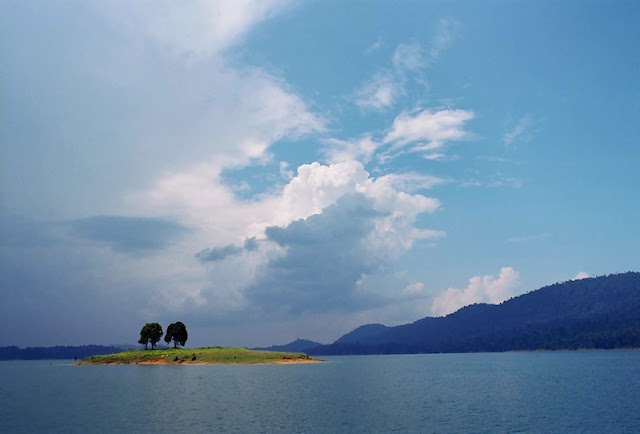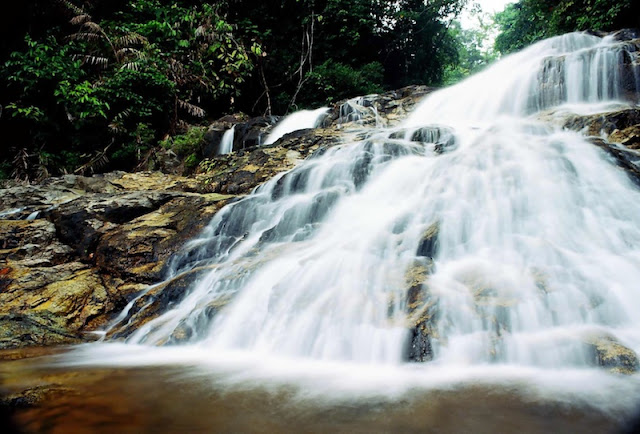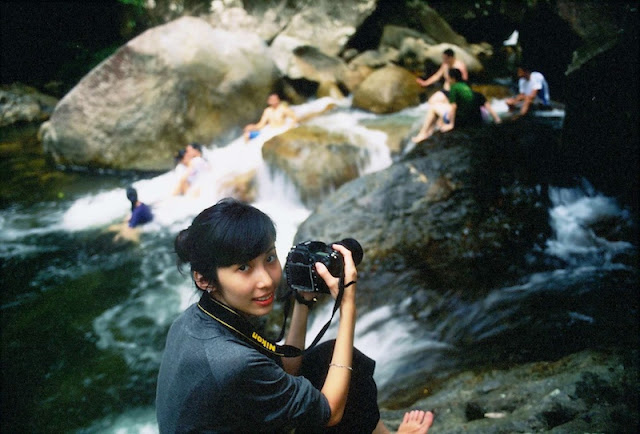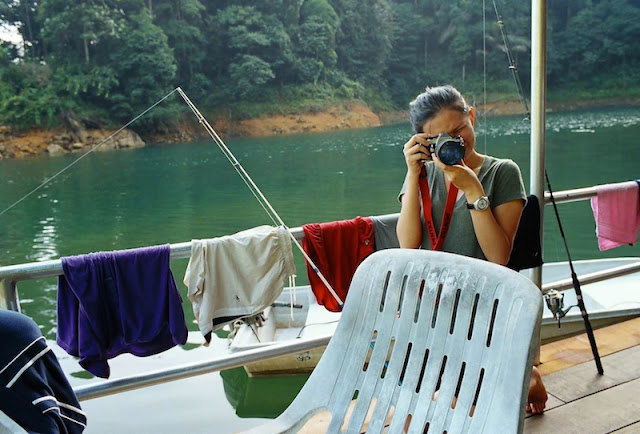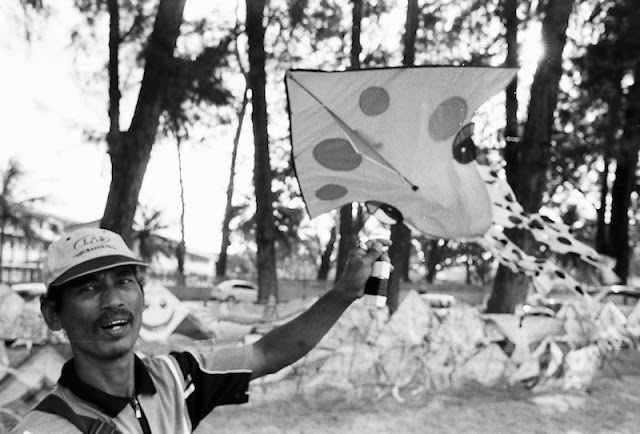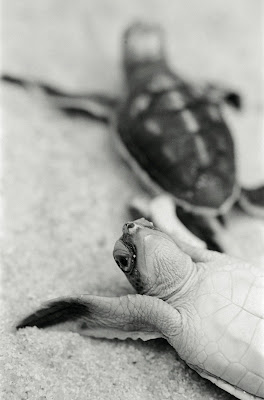When Jia Hui asked if I would like to join Poh Fong, Chern Zhong and her on SEATRU, I immediately jumped at the offer. I think it was Steph Yiau who first told me about it—could've been during the Pangkor 2009 trip—but I never got down to doing it during my undergradaute days.
No longer a student, I had to pay the full fee last year (RM700 for food and board). But it wasn't the kind of opportunity that comes every other day, least of all with a group of friends.
SEATRU is the turtle conservation programme run by Universiti Malaysia Terengganu (UMT). Every nesting season (roughly April to September), they have openings for volunteers, typically no more than eight volunteers a week. There's a lot more about SEATRU, and how to volunteer, on their blog
here.
Ours was Slot J, 4-11 June 2011.
* * *
Jia Hui, Poh Fong, Chern Zhong and I met up in KL Sentral on Friday, 3 June, to take the bus to the LCCT for our flight to Kuala Terengganu (KT). Fellow volunteer Cassey (University of Nottingham, Malaysia campus) also met us there; she had gotten in touch with Chern Zhong, having tracked him down on Facebook or something.
We spent the night in KT and took a taxi the next morning to meet the rest—the three boys from the Multimedia University (MMU), and programme research assistants Lionel and Yana—at the UMT campus.
There, we were taken on a brief tour of the campus by some of the Marine Biology/Marine Science students who had showed up to say hello.
Back: Poh Fong, Cassey, Yew Kiat, Xavier, Khoon Foo
Front: Jia Hui, Ben, Chern Zhong
The eight of us, with relatively fair skin compared to the tanned complexion we would all have by the end of the week.
(Can't remember who took the picture, though.)
Now, for a brief run-through on the daily routine at Chagar Hutang, the tranquil northern coast of Redang where SEATRU is based.
First, turtles mate. Alright, this wasn't exactly daily routine, but we encountered this pair on the way back from the round-island snorkelling trip (which wasn't devoid of its own drama—but more on that later).
The pair had surfaced for air, which is a relatively uncommon phenomenon to observe. But of course, turtles being reptiles, they still breathe through lungs. Without a gas exchange system that can function in water, they need to surface for air every now and then.
A nesting female preparing the burrow in which to lay her eggs.
Their flippers are extremely strong, an a first-hand encounter with the might of the swing can be a rather painful experience.
Observing a nesting turtle as she lays her eggs.
In order not to distract or disturb the turtle, we usually sit at a distance while the turtle prepares her nest, and only approach once she starts laying her eggs or so, at which point she would typically not abort the 'mission' anymore. Also, red light (instead of the usual yellow or white lights) is used as it is less glaring; not all torch lights have this feature, but the Energizer headlamp does.
The entire process from landing to camouflaging (covering the nest with sand) and returning to sea can take up to three or four hours. For this reason, turtles usually land before midnight. To land later would mean completing the nesting by dawn, at which time it would already be quite bright.
Turtle tracks.
While these are easy to spot in the day, the challenge is to look out for them at night, during our hourly patrols of the beach. It is one of the ways—short of actually seeing the turtle—by which we identify that a turtle has landed. Because the patrols are only done hourly, a turtle may have worked her way rather inland by the time of the next patrol.
The locations of the nests are marked at night, but detailed location data (e.g., coordinates) are only taken the next morning. The nests are also covered in mesh netting to prevent predation by large animals such as the monitor lizard.
Excavation of nests.
This is usually done in the evening, during which we excavate nests that have incubated for more than 40 days. By then, some of the eggs would be expected to have hatched. Thereafter, the nests are checked at an interval of three days.
(Photo possibly by Yoong Khang.)
If all is well, this is what we should see: a mix of hatchlings and unhatched eggs, in good condition. One of the frequently encountered problems is attack by ants, which love the juicy, meaty, helpless hatchlings. When a nest is discovered to be under ant attack, the hatchlings are either relocated to a different spot, or completely excavated and kept in a shaded container pending manual release to the sea.
Lionel re-buries the hatchlings.
Sometimes, hatchlings are found quite near the surface, in which case they will be expected to undertake their exodus into the ocean within a day or two—more typically, that very night itself. They are re-buried so that they may only emerge when it is dark; the light can really mess up their navigation instinct.
Excavated turtle hatchlings in the container trays.
The average turtle hatchling is no larger than the palm of your hand (or the hand of a small person), and their shells are relatively soft. It is difficult to imagine that these young ones may someday grow into one of the most massive and impressive creatures of the sea.
Part of our daily routine involves making sure that people don't land on the Chagar Hutang beach, including, and especially, tourists.
At the beginning and the end of our week on Chagar Hutang, we carried out
gotong royong along the entire 1-kilometre stretch of the beach. Most of the litter is washed up from the distant ocean, and we even found some Vietnamese bottles among the rocks on the western end of the beach.
Turtles are not the only animals encountered at Chagar Hutang.
Comel the squirrel was a regular at the kitchen/dining area in the afternoons. He/she is a rather fat rodent (no prizes for guessing the food source), shy as squirrels are wont to be, but also a sucker for a snack.
The elusive monitor lizard.
They will scavenge for anything, and are frequently seen in the afternoons (when everyone is asleep) near the charred excavation remnants. After every nest excavation, the hatched shells, discarded eggs and dead hatchlings are burnt so as not to allow rotting and attract flies.
I managed a few shots; stalking monitor lizards is by no means an easy feet, and this particular effort required some careful balancing on wooden beams, as well as willful ignorance of Chern Zhong's calls.
The even more elusive mousedeer.
This was arguably the highlight of all the afternoon stalking. It was on the afternoon of the fifth day (Wednesday) that some of us (I think Yoong Khang and Jol Ern were there) noticed a mousedeer, or
kancil, prowling about the rubbish pile near the bench at the entrance. We immediately crept up to Lionel's 'office' and took sniper-like positions behind the low wooden walls.
The mousedeer is a very shy and alert animal, and is very sensitive to movement. We couldn't get any closer, and so we had to patiently wait for it to come near again, having darted off a few times into the nearby forest.
It was, I think, my first face-to-face encounter with a mousedeer in the wild.
Hermit crabs were relatively abundant on the shore as well as near the kitchen and at the charring 'pits', scavenging, like the monitor lizards, for anything and everything.
Crabs—usually ghost crabs—were also commonly encountered, though much more difficult to catch. These are among the predators of turtle eggs, snipping them open with their large claws and helping themselves to the yummy egg contents.
Zetty, a UMT student doing her final-year project/thesis on crabs, was based in Chagar Hutang for the semester break, along with her coursemate Yoong Khang, who was working on weighing turtles (using an imposing contraption that took four to five full-sized men to operate effectively).
We had, true to the description in the volunteer handbook, a lot of free time during the day (which is punctuated only by occasional patrol duty and rotational cooking duties). Most of the hard turtle work was only done in the evenings and at night.
Pasta a la Lionel.
There were some fun cookouts, and this was one of them. Everyone usually chipped in to prepare the meals.
Round the table, from left: Cassey, Chern Zhong, Jia Hui, Poh Fong, Yoong Khang, Yew Kiat, Khoon Foo, Xavier, Zetty, Jol Ern and Lionel.
Candlelit nights in the dining area.
Lionel and Jol Ern (a USM graduate student conducting research at Chagar Hutang), being the 'bosses', would sit/sleep in the dining area/office (which doubled as a sleeping space), while the hourly patrols—after midnight—would take turns keeping an eye on the beach.
From 8.00pm until midnight, patrols were done as a group. We did have some inventive variations on that theme (especially with four teachers in the company!), such as patrols by prime/non-prime numbers; we each had a number, according to our list on the roster.
Tuesday night was particularly memorable. We were huddled up in the office as it was raining heavily outside, and thus, no one could go on patrol and no turtles were likely to land anyway. Seated in a circle, we told stories, and it was there that I came up with a practically random long story about the Sky Kingdom (nothing to do with Ayah Pin!) and the Sea Kingdom. It was also on this occasion that a number of the motifs for my short story, 'The Sky is Blue', came about.
The short poem '
All Our Scars are Stories' was written in response to Cassey's injury the day before.
On Monday, we went on a round-island snorkelling trip. At our first stop, I jumped into the water with my camera held above the water, and began swimming to the nearby island, from which I hoped to get some nice shots.
I was some distance from the boat when some of the others noticed I had my camera with me and started exclaiming. It was then that Cassey suddenly realised her camera (a Panasonic Lumix LX3 or LX5) was still slung in its case, round her neck, beneath the life jacket. She immediately climbed back into the boat, and I followed suit to assess the damage.
She'd put on her life jacket earlier, forgetting—probably in the midst of all the excitement—to take the camera off her neck first. It was drenched, in sea water no less, and so we emptied someone's water bottle—the freshest water we could find—into a pail and left the camera to soak in it.
But this was nothing compared to what happened next. Cassey turned around to go back into the water, accidentally slicing her leg, near the shin, on a jutting metal hinge below the cushioned seats of the boat. (In retrospect, that hinge should have been checked for before we embarked; I guess no one thought something like this could happen.)
With some immediate first-aid (hand sanitiser alcohol and my Nikon t-shirt as makeshift bandage), we were rushed off by boatman and staff-on-duty Mahadi to the nearby Laguna Beach Resort, where we hoped to find a doctor. We were very quickly attended to by the very competent Dr Rupar Kyi Tin (of Myanmar), who immediately treated the wound and stitched it up.
That put paid to Cassey's snorkelling over the next two or three days, but later in the week she was back in the sea with the best protection waterproof plasters could afford.
Siesta.
Our accommodation was in the form of mats (not mattresses) in wooden huts, but never once did I sleep in the huts. The afternoons were, more often than not, spent in the hammocks outside the huts, while my nights were mostly spent on the beach itself, which is so beautiful beneath all the stars that, after a week of shared stargazing experiences with the others—especially staff members like Mahadi—I left my copy of Ian Ridpath's
Stars and Planets at Chagar Hutang. (I've yet to get a replacement, in fact!)
The river behind the SEATRU base, from which we got our supply of freshwater.
Further upstream, there were a series of small cascades, and a decent-sized pool which was dubbed the 'Prawn Spa' on account of the small crustaceans that would come and nibble at our feet, in the same way the fish of today's popular fish spas do.
Jia Hui on the beach.
It was Wednesday morning at 6.30am, and the dawn sky was the most gorgeous it would get that whole week. I was asleep in the dining area and immediately ran out with my camera, to find that Jia Hui was already there. But I ended up missing some of the best colours due to some fumbling with the gorillapod and cable release.
Thursday afternoon was spent hiking up to 'Turtle Rock', the eastern cape of Chagar Hutang, a very awesome, 'top of the world' experience.
View of the ocean from near the peak of Turtle Rock. When they use words like 'azure', 'turquoise' or 'crystal' to describe water, this is what I imagine it to be, and so much more.
And the plants and shrubs that cling to the rocks, typical of windswept islands. Such a metaphor for life! Life that is not always cosy and comfortable, life that is meant for the living and the roughing it out.
Mann against the sea.
It was he who carved out the trail to Turtle Rock many years ago; he and Mahadi have been with SEATRU for over 14 years, if I'm not mistaken.
Cassey and the souvenir rock we left behind; every group leaves something behind, either an inscription on cloth, on wood, or something of the sort.
Hawksbill Turtle.
Two species of turtle are known to nest on Chagar Hutang, the Green Turtle and the much rarer Hawksbill. It was the final night, Friday, and all we'd seen so far were Green Turtles. When we least expected it, a Hawksbill landed that night, and someone—I think it was Chern Zhong—roused me from my sleep to see it.
It was certainly the perfect end to an already unbelievable week.
SEATRU Slot J, 2011.
Back: Mahadi, Mann, Chern Zhong and Lionel.
Middle: Khoon Foo, Yew Kiat, Jia Hui, Zetty, Jol Ern, Poh Fong and Xavier.
Front: Ben, Cassey and Yoong Khang.
Back in the 'real world', things were not nearly as rosy.
The snorkelling rush.
Snorkellers at the stretch of beach near the Laguna Beach Resort. Sometimes I wonder, when you've got nearly a hundred people in the sea with you, what do you expect to see, seriously? Mass tourism may work for huge theme parks, but for viewing nature up-close?
Turtle eggs being sold at the Pasar Payang in KT.
Demand for this delicacy is apparently still alive and well. One of the methods of consumption involves boiling in
pandan water.
Egg poachers are among the greatest threats to the survival of turtles; it is so difficult for a female to surface and nest, and even harder for hatchlings to survive in the cruel ocean, that removal of eggs from their nests is virtually guaranteed to bring about the swift extinction of this venerable reptile.
Waiting for the bus, KT.
The bus was suspiciously delayed; it was there in the bay, but the driver was nowhere to be found. It was later learned that the 30-minute delay was due to the Kelantan-Terengganu football match, which, thankfully, Terengganu won. Had the state team lost, I have no idea what sort of mood the driver would've been in!
Another reason for my not liking buses: we purchased tickets (via the internet, and much earlier at that) for what was supposed to be an 'above-average' bus, with rows of three seats (the 2+1 sort), but we got a normal four-in-a-row bus instead.
Jia Hui and B031, Klang Bus Station.
We arrived really early in the morning (was it 5.30am?) at the Putra Bus Station (Hentian Putra), and waited quite a long time for the Komuter (a longish queue at the ticket machines) to Bandar Tasik Selatan, where we saw Poh Fong off.
I then dropped Jia Hui off at the Klang Bus Station, where she took a bus to Banting to meet with Adelene. It wasn't long after that, I think, that the Klang Bus Station was decommissioned; so this became yet another 'last' of recent years.
SEATRU was, on the whole, such an enriching and educational experience. I thought of doing it again this year, but then I learnt that Lionel is no longer there. It won't be quite the same; not returning to see a friend as I'd hoped it to be.
* * *
Technical matters:
I can see why professional wildlife shooters would appreciate cameras like the Nikon D3s, with fantastic high ISO performance. There really is no other way to shoot phenomena like nesting turtles without using external lights, which would disturb the turtles.
B&W images shot on TriX, colour on Fuji Xtra 400. Photos after leaving Chagar Hutang shot on Kodak ColorPlus 200, which I purchased at the Laguna Redang Resort. N80 camera with 50mm and 70-210mm lenses, on which polarising and yellow filters were frequently used, respectively.




